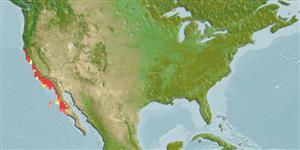Environment: milieu / climate zone / depth range / distribution range
Écologie
marin bathydémersal; profondeur 20 - 500 m (Ref. 49962), usually 90 - 300 m (Ref. 49962). Deep-water; 40°N - 27°N, 125°W - 113°W
Eastern Central Pacific: Usal, Mendocino County in central California, USA to central Baja California and Guadalupe Island (off north central Baja California) in Mexico.
Length at first maturity / Taille / Poids / Âge
Maturity: Lm 39.3, range 42 - 52 cm
Max length : 100.0 cm FL mâle / non sexé; (Ref. 49962); poids max. publié: 13.0 kg (Ref. 2850); âge max. reporté: 55 années (Ref. 49962)
Description synthétique
Clés d'identification | Morphologie | Morphométrie
Épines dorsales (Total) : 13 - 14; Rayons mous dorsaux (Total) : 12 - 13; Épines anales: 3; Rayons mous anaux: 6 - 7; Vertèbres: 26. Branchiostegal rays: 7 (Ref. 36715).
Found on the bottom at moderate depths, to 366 m (Ref. 2850). Juveniles are pelagic (Ref. 36715), over fine sand and clay, whereas adults (>44 cm TL) inhabit rocky areas at 90-300 m (Ref. 49962). Viviparous, with planktonic larvae (Ref. 36715).
Eschmeyer, W.N., E.S. Herald and H. Hammann, 1983. A field guide to Pacific coast fishes of North America. Boston (MA, USA): Houghton Mifflin Company. xii+336 p. (Ref. 2850)
Statut dans la liste rouge de l'IUCN (Ref. 130435)
Menace pour l'homme
Harmless
Utilisations par l'homme
Pêcheries: commercial; pêche sportive: oui
Outils
Articles particuliers
Télécharger en XML
Sources Internet
Estimates based on models
Preferred temperature (Ref.
123201): 7.8 - 11.5, mean 8.8 °C (based on 16 cells).
Phylogenetic diversity index (Ref.
82804): PD
50 = 0.5000 [Uniqueness, from 0.5 = low to 2.0 = high].
Bayesian length-weight: a=0.01023 (0.00559 - 0.01873), b=3.09 (2.94 - 3.24), in cm total length, based on LWR estimates for this species & Genus-body shape (Ref.
93245).
Niveau trophique (Ref.
69278): 3.9 ±0.5 se; based on size and trophs of closest relatives
Generation time: 21.0 ( na - na) years. Estimated as median ln(3)/K based on 2
growth studies.
Résilience (Ref.
120179): Très faible, temps minimum de doublement de population supérieur à 14 ans (tm=11-12; tmax=55; K=0.05).
Prior r = 0.28, 95% CL = 0.18 - 0.41, Based on 2 full stock assessments.
Fishing Vulnerability (Ref.
59153): High to very high vulnerability (70 of 100).
